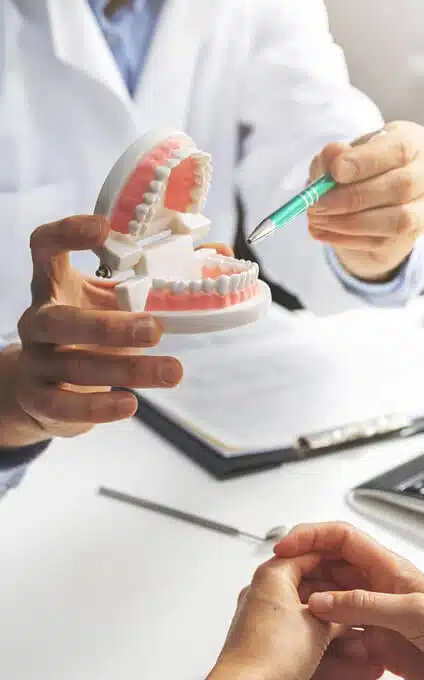Periodontal Disease Treatment in Lubbock
- Home
- Periodontal Disease
How do I know if I have gum disease?
- Signs and Symptoms:
- Bad breath that won’t go away
- Red or swollen gums
- Tender and bleeding gums
- Painful chewing
- Bad taste
- New spaces that develop between your teeth
- New spaces that develop between your teeth
- Sensitive or loose teeth
- A change in the way your teeth fit together
- Receding gums or longer appearing teeth
Any of these symptoms may be a sign of a serious problem which should be checked by a general dentist or dental hygienist or a specialist (called a periodontist). The dentist or dental hygienist can test you for gum disease and may also take x-rays to determine whether there is any bone loss. They may also refer you to a periodontist who are experts in the diagnosis and treatment of gum disease and may provide you with treatment options that are not offered by your dentist.


Healthy Gum Tissue

Gingivitis

Periodontitis

Advanced Periodontitis
Stages of Gum Disease
Stage 1: Gingivitis
Stage 2: Periodontitis
Stage 3: Advanced Periodontitis
How is gum disease treated?
- Much less discomfort.
- A little bleeding.
- Faster healing.
- Preservation of tooth structure.
- Reduced risk of post-operative infection.
Dr. Gilliam and Dr. Mattlage are two of only a few hundred dentists in the country licensed to use this laser technology. When your gum disease is stopped, slowed down, or gets worse depends greatly on your taking the first step. Ask your dentist or dental hygienist if you have gum disease, or contact our office at the Lubbock Dental Implant Center.
Both doctors encourage any patient to seek a second opinion regarding the treatment of their periodontal disease. Patients can save hundreds of dollars in our office with laser periodontal therapy in most cases. This laser technology can also be used to save failing implants.
Treatment Options
- Oral cancer screening
- Exams/X-Rays/Cleanings/Home care instructions
- Scaling and root planing (deep cleaning)
- Crown lengthening
- Cosmetic gum reshaping
- Cosmetic gum grafting
- Bone regeneration
- Root amputation
- Laser gum surgery
- Night guard appliances
- Treatment of failing implants
- Intravenous (IV) sedation
What to expect from our free consultation.
Meet the Doctor
Receive Your Treatment Plan
Get Your Treatment Price
You may be surprised by how affordable dental implants are at our office. Once the doctor works up your treatment plan, you will know exactly how much dental implants will cost you. We will also discuss payment options and the next step if you decide dental implants are right for you.

Comparing Dental Implants to Dentures & Conventional Bridges
Patient Forms

